Input interpretation

H_2 hydrogen + SO_2 sulfur dioxide + NO nitric oxide ⟶ H_2SO_4 sulfuric acid + N_2O nitrous oxide
Balanced equation
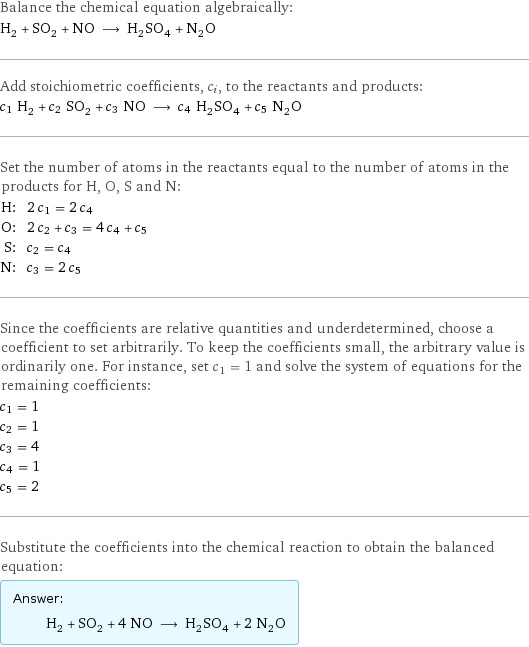
Balance the chemical equation algebraically: H_2 + SO_2 + NO ⟶ H_2SO_4 + N_2O Add stoichiometric coefficients, c_i, to the reactants and products: c_1 H_2 + c_2 SO_2 + c_3 NO ⟶ c_4 H_2SO_4 + c_5 N_2O Set the number of atoms in the reactants equal to the number of atoms in the products for H, O, S and N: H: | 2 c_1 = 2 c_4 O: | 2 c_2 + c_3 = 4 c_4 + c_5 S: | c_2 = c_4 N: | c_3 = 2 c_5 Since the coefficients are relative quantities and underdetermined, choose a coefficient to set arbitrarily. To keep the coefficients small, the arbitrary value is ordinarily one. For instance, set c_1 = 1 and solve the system of equations for the remaining coefficients: c_1 = 1 c_2 = 1 c_3 = 4 c_4 = 1 c_5 = 2 Substitute the coefficients into the chemical reaction to obtain the balanced equation: Answer: | | H_2 + SO_2 + 4 NO ⟶ H_2SO_4 + 2 N_2O
Structures

+ + ⟶ +
Names

hydrogen + sulfur dioxide + nitric oxide ⟶ sulfuric acid + nitrous oxide
Reaction thermodynamics
Enthalpy
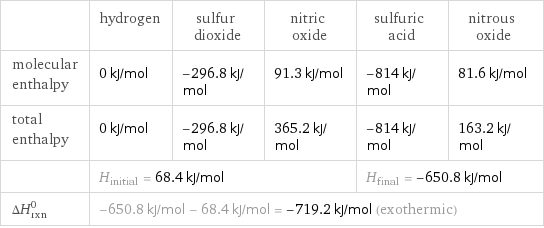
| hydrogen | sulfur dioxide | nitric oxide | sulfuric acid | nitrous oxide molecular enthalpy | 0 kJ/mol | -296.8 kJ/mol | 91.3 kJ/mol | -814 kJ/mol | 81.6 kJ/mol total enthalpy | 0 kJ/mol | -296.8 kJ/mol | 365.2 kJ/mol | -814 kJ/mol | 163.2 kJ/mol | H_initial = 68.4 kJ/mol | | | H_final = -650.8 kJ/mol | ΔH_rxn^0 | -650.8 kJ/mol - 68.4 kJ/mol = -719.2 kJ/mol (exothermic) | | | |
Gibbs free energy
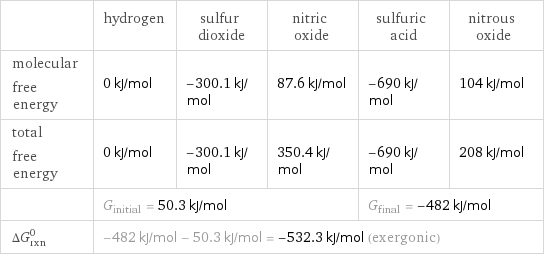
| hydrogen | sulfur dioxide | nitric oxide | sulfuric acid | nitrous oxide molecular free energy | 0 kJ/mol | -300.1 kJ/mol | 87.6 kJ/mol | -690 kJ/mol | 104 kJ/mol total free energy | 0 kJ/mol | -300.1 kJ/mol | 350.4 kJ/mol | -690 kJ/mol | 208 kJ/mol | G_initial = 50.3 kJ/mol | | | G_final = -482 kJ/mol | ΔG_rxn^0 | -482 kJ/mol - 50.3 kJ/mol = -532.3 kJ/mol (exergonic) | | | |
Entropy
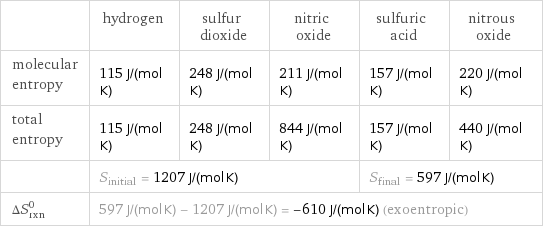
| hydrogen | sulfur dioxide | nitric oxide | sulfuric acid | nitrous oxide molecular entropy | 115 J/(mol K) | 248 J/(mol K) | 211 J/(mol K) | 157 J/(mol K) | 220 J/(mol K) total entropy | 115 J/(mol K) | 248 J/(mol K) | 844 J/(mol K) | 157 J/(mol K) | 440 J/(mol K) | S_initial = 1207 J/(mol K) | | | S_final = 597 J/(mol K) | ΔS_rxn^0 | 597 J/(mol K) - 1207 J/(mol K) = -610 J/(mol K) (exoentropic) | | | |
Equilibrium constant
![Construct the equilibrium constant, K, expression for: H_2 + SO_2 + NO ⟶ H_2SO_4 + N_2O Plan: • Balance the chemical equation. • Determine the stoichiometric numbers. • Assemble the activity expression for each chemical species. • Use the activity expressions to build the equilibrium constant expression. Write the balanced chemical equation: H_2 + SO_2 + 4 NO ⟶ H_2SO_4 + 2 N_2O Assign stoichiometric numbers, ν_i, using the stoichiometric coefficients, c_i, from the balanced chemical equation in the following manner: ν_i = -c_i for reactants and ν_i = c_i for products: chemical species | c_i | ν_i H_2 | 1 | -1 SO_2 | 1 | -1 NO | 4 | -4 H_2SO_4 | 1 | 1 N_2O | 2 | 2 Assemble the activity expressions accounting for the state of matter and ν_i: chemical species | c_i | ν_i | activity expression H_2 | 1 | -1 | ([H2])^(-1) SO_2 | 1 | -1 | ([SO2])^(-1) NO | 4 | -4 | ([NO])^(-4) H_2SO_4 | 1 | 1 | [H2SO4] N_2O | 2 | 2 | ([N2O])^2 The equilibrium constant symbol in the concentration basis is: K_c Mulitply the activity expressions to arrive at the K_c expression: Answer: | | K_c = ([H2])^(-1) ([SO2])^(-1) ([NO])^(-4) [H2SO4] ([N2O])^2 = ([H2SO4] ([N2O])^2)/([H2] [SO2] ([NO])^4)](../image_source/4b070600801a2bee36f86ca9671996ae.png)
Construct the equilibrium constant, K, expression for: H_2 + SO_2 + NO ⟶ H_2SO_4 + N_2O Plan: • Balance the chemical equation. • Determine the stoichiometric numbers. • Assemble the activity expression for each chemical species. • Use the activity expressions to build the equilibrium constant expression. Write the balanced chemical equation: H_2 + SO_2 + 4 NO ⟶ H_2SO_4 + 2 N_2O Assign stoichiometric numbers, ν_i, using the stoichiometric coefficients, c_i, from the balanced chemical equation in the following manner: ν_i = -c_i for reactants and ν_i = c_i for products: chemical species | c_i | ν_i H_2 | 1 | -1 SO_2 | 1 | -1 NO | 4 | -4 H_2SO_4 | 1 | 1 N_2O | 2 | 2 Assemble the activity expressions accounting for the state of matter and ν_i: chemical species | c_i | ν_i | activity expression H_2 | 1 | -1 | ([H2])^(-1) SO_2 | 1 | -1 | ([SO2])^(-1) NO | 4 | -4 | ([NO])^(-4) H_2SO_4 | 1 | 1 | [H2SO4] N_2O | 2 | 2 | ([N2O])^2 The equilibrium constant symbol in the concentration basis is: K_c Mulitply the activity expressions to arrive at the K_c expression: Answer: | | K_c = ([H2])^(-1) ([SO2])^(-1) ([NO])^(-4) [H2SO4] ([N2O])^2 = ([H2SO4] ([N2O])^2)/([H2] [SO2] ([NO])^4)
Rate of reaction
![Construct the rate of reaction expression for: H_2 + SO_2 + NO ⟶ H_2SO_4 + N_2O Plan: • Balance the chemical equation. • Determine the stoichiometric numbers. • Assemble the rate term for each chemical species. • Write the rate of reaction expression. Write the balanced chemical equation: H_2 + SO_2 + 4 NO ⟶ H_2SO_4 + 2 N_2O Assign stoichiometric numbers, ν_i, using the stoichiometric coefficients, c_i, from the balanced chemical equation in the following manner: ν_i = -c_i for reactants and ν_i = c_i for products: chemical species | c_i | ν_i H_2 | 1 | -1 SO_2 | 1 | -1 NO | 4 | -4 H_2SO_4 | 1 | 1 N_2O | 2 | 2 The rate term for each chemical species, B_i, is 1/ν_i(Δ[B_i])/(Δt) where [B_i] is the amount concentration and t is time: chemical species | c_i | ν_i | rate term H_2 | 1 | -1 | -(Δ[H2])/(Δt) SO_2 | 1 | -1 | -(Δ[SO2])/(Δt) NO | 4 | -4 | -1/4 (Δ[NO])/(Δt) H_2SO_4 | 1 | 1 | (Δ[H2SO4])/(Δt) N_2O | 2 | 2 | 1/2 (Δ[N2O])/(Δt) (for infinitesimal rate of change, replace Δ with d) Set the rate terms equal to each other to arrive at the rate expression: Answer: | | rate = -(Δ[H2])/(Δt) = -(Δ[SO2])/(Δt) = -1/4 (Δ[NO])/(Δt) = (Δ[H2SO4])/(Δt) = 1/2 (Δ[N2O])/(Δt) (assuming constant volume and no accumulation of intermediates or side products)](../image_source/a383302a0d72bfd148de6efad814fd7d.png)
Construct the rate of reaction expression for: H_2 + SO_2 + NO ⟶ H_2SO_4 + N_2O Plan: • Balance the chemical equation. • Determine the stoichiometric numbers. • Assemble the rate term for each chemical species. • Write the rate of reaction expression. Write the balanced chemical equation: H_2 + SO_2 + 4 NO ⟶ H_2SO_4 + 2 N_2O Assign stoichiometric numbers, ν_i, using the stoichiometric coefficients, c_i, from the balanced chemical equation in the following manner: ν_i = -c_i for reactants and ν_i = c_i for products: chemical species | c_i | ν_i H_2 | 1 | -1 SO_2 | 1 | -1 NO | 4 | -4 H_2SO_4 | 1 | 1 N_2O | 2 | 2 The rate term for each chemical species, B_i, is 1/ν_i(Δ[B_i])/(Δt) where [B_i] is the amount concentration and t is time: chemical species | c_i | ν_i | rate term H_2 | 1 | -1 | -(Δ[H2])/(Δt) SO_2 | 1 | -1 | -(Δ[SO2])/(Δt) NO | 4 | -4 | -1/4 (Δ[NO])/(Δt) H_2SO_4 | 1 | 1 | (Δ[H2SO4])/(Δt) N_2O | 2 | 2 | 1/2 (Δ[N2O])/(Δt) (for infinitesimal rate of change, replace Δ with d) Set the rate terms equal to each other to arrive at the rate expression: Answer: | | rate = -(Δ[H2])/(Δt) = -(Δ[SO2])/(Δt) = -1/4 (Δ[NO])/(Δt) = (Δ[H2SO4])/(Δt) = 1/2 (Δ[N2O])/(Δt) (assuming constant volume and no accumulation of intermediates or side products)
Chemical names and formulas
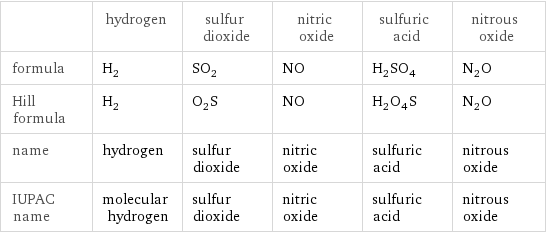
| hydrogen | sulfur dioxide | nitric oxide | sulfuric acid | nitrous oxide formula | H_2 | SO_2 | NO | H_2SO_4 | N_2O Hill formula | H_2 | O_2S | NO | H_2O_4S | N_2O name | hydrogen | sulfur dioxide | nitric oxide | sulfuric acid | nitrous oxide IUPAC name | molecular hydrogen | sulfur dioxide | nitric oxide | sulfuric acid | nitrous oxide
Substance properties
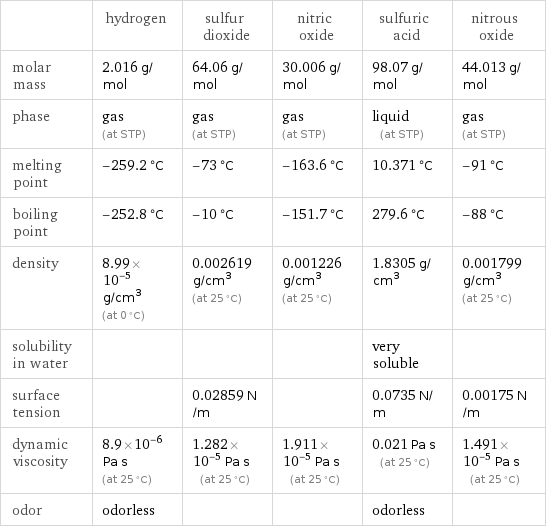
| hydrogen | sulfur dioxide | nitric oxide | sulfuric acid | nitrous oxide molar mass | 2.016 g/mol | 64.06 g/mol | 30.006 g/mol | 98.07 g/mol | 44.013 g/mol phase | gas (at STP) | gas (at STP) | gas (at STP) | liquid (at STP) | gas (at STP) melting point | -259.2 °C | -73 °C | -163.6 °C | 10.371 °C | -91 °C boiling point | -252.8 °C | -10 °C | -151.7 °C | 279.6 °C | -88 °C density | 8.99×10^-5 g/cm^3 (at 0 °C) | 0.002619 g/cm^3 (at 25 °C) | 0.001226 g/cm^3 (at 25 °C) | 1.8305 g/cm^3 | 0.001799 g/cm^3 (at 25 °C) solubility in water | | | | very soluble | surface tension | | 0.02859 N/m | | 0.0735 N/m | 0.00175 N/m dynamic viscosity | 8.9×10^-6 Pa s (at 25 °C) | 1.282×10^-5 Pa s (at 25 °C) | 1.911×10^-5 Pa s (at 25 °C) | 0.021 Pa s (at 25 °C) | 1.491×10^-5 Pa s (at 25 °C) odor | odorless | | | odorless |
Units
